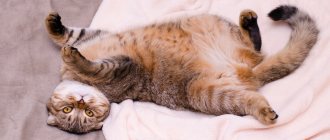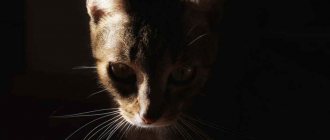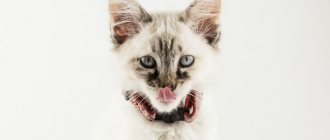All representatives of the cat family are distinguished by natural dexterity and grace, but this property is not always able to protect them from injury. In addition, the world is full of unkind people who may not like these furry fidgets, and therefore are quite capable of causing them intentional harm. Therefore, every responsible owner should be aware of what a concussion is in cats.
Veterinarians note that concussion is not an independent disease, but is only a consequence of the injury received. However, it should not be underestimated, since as a result of a head injury, the animal may experience hemorrhage in the brain or its compression inside the skull. All this leads to dangerous dysfunction of the motor and central nervous systems, which affects the entire life activity of the tailed friend.
The insidiousness of a concussion is that it may not manifest itself in any way for quite a long time, and then suddenly the cat begins to have seizures or develop chronic heart disease on its own. Therefore, owners should remember that even the most insignificant at first glance head injury to a mustachioed friend can have very serious consequences. The article will discuss the causes of a concussion in a cat, and will also discuss the symptoms and treatment of this disease.
Causes of the disease
Statistics show that the most common causes of a concussion in a cat are:
- Collision with road vehicles: cars, motorcycles, scooters and even bicycles.
- Falling from a great height, unsuccessful landing when jumping from a tree to the ground. This is especially true for those pets who have the right to walk freely wherever they please. However, domestic cats are also at risk, as they often fall off balconies and window sills. Most often this happens in the summer, when apartment windows are wide open.
- Deliberate harm by hooligans. Unfortunately, in our time there are still enough people walking the streets of the city who find pleasure in inflicting pain on a weaker creature.
- Heavy objects falling on your pet's head. Such injuries are most dangerous for a small kitten, which simply will not have time to orient itself in the current situation and will not jump to the side. In addition, his skull is not yet strong enough, which means the consequences of the accident could be disastrous.
- In pursuit of prey, a furry predator is capable of reaching such a level of excitement that it may simply not notice a suddenly arising obstacle and slow down in front of it.
- Sometimes the owners themselves cause head injuries to a mustachioed friend by opening the door too sharply or accidentally stepping on the cat while it was sleeping.
Prevention
There are no special preventive measures to prevent the occurrence of osteoma. Doctors recommend taking an x-ray every year to detect the tumor in a timely manner and, if necessary, remove it.
Specialists of the medical surgical department successfully perform operations to remove various types of osteomas. If you notice a lump on any bone, contact a specialist who will make a diagnosis and promptly prescribe treatment.
There is no special prevention for this disease. The main cause of osteomas is considered to be genetic predisposition.
Some recommendations:
- avoid injury;
- timely cure diseases of the musculoskeletal system;
- undergo examination if any neoplasms of unknown origin are detected.
Symptoms of the disease
The main symptom of a concussion in cats is that when an injury occurs, the animal immediately loses consciousness. The pet “passes out” for a couple of minutes, and when it comes to its senses, it looks stunned. He may have short-term memory loss; at first he may not recognize the owner, run away from inspection attempts, and even attack the owner. It is important to understand that the longer the pet lies unconscious, the stronger the concussion.
The main signs of a concussion consist of the following characteristic manifestations:
- the eyeball begins to tremble (nystagmus);
- the pet’s pupils have different sizes and react poorly to light stimuli;
- the mucous membranes become excessively red, or, conversely, turn pale;
- coordination of movements is impaired;
- the respiratory process is disrupted, wheezing is heard when exhaling;
- due to a severe headache, the cat rests its muzzle against the wall;
- apathy and loss of interest in food;
- vomit;
- the cat's limbs twitch involuntarily;
- you can find a hematoma or bruises on your pet’s head;
- paw paralysis
The stronger the injury, the more severe the symptoms. However, even if signs practically do not appear, this does not mean that your furry friend does not need to be shown to the veterinarian as soon as possible. If this is not done immediately after a concussion, the pet faces the risk of disruption of proper blood circulation in this organ, an increase in intracranial pressure, as well as hemorrhage in the brain, which can turn it into a disabled person.
First aid
So, the owner has witnessed that his pet has suffered a head injury and is unconscious, what to do in such cases? First of all, veterinarians recommend carefully moving the cat to a quiet room without bright sources of light and laying it on its side. The main condition is not to try to revive your pet yourself using ammonia or cold water. He must come to consciousness on his own.
If your tongue gets stuck, protect your furry friend from suffocation by using a clean cloth or napkin to try to pull him out of the cat’s mouth. Such a measure is also necessary as insurance against the animal choking on vomit. If there is a clearly visible, open wound on the head, try to rinse it with warm water and then treat it with an antiseptic. Apply a cold compress to the injury site.
Monitor the cat's heartbeat; in case of cardiac arrest, perform artificial respiration and massage this organ. Do not forget that as a result of the resulting concussion, the cat may quite possibly not recognize its owner for 1-2 days. Be patient and don't get upset by the animal's aggressiveness.
Transportation of the mustachioed friend to the veterinary hospital is carried out on a hard surface. Under no circumstances should you use a carrier; it is better to carry the cat in your arms, trying to keep the pet on its side. The most ideal option is a cardboard box with a wide bottom. Lying in it, the animal does not experience severe shaking, which means that the risk of a sudden onset of brain hemorrhage will be insignificant.
How to help a stroke victim?
Recovery largely depends on how the people around the patient behave. First of all, you need to call an ambulance, and until it arrives, try not to move the person. You need to place a cushion or pillow under the shoulders and head, carefully turn the person on the right side, and place a basin or bag in case of vomiting. It is advisable to measure blood pressure. Anti-pressure pills should not be given before the ambulance arrives: there is a possibility of a sharp drop in blood pressure. Only specially trained medical personnel know the rules for lowering blood pressure when it rises above 150/100 mmHg. If respiratory depression occurs, you need to start resuscitation - chest compressions, mouth-to-mouth breathing.
The best prevention is timely treatment of hypertension, atherosclerosis, identification of malformations and aneurysms before they rupture.
Our neurologists see patients every day, and every patient at the clinic can find out their risk for developing a hemorrhagic stroke. Visit your doctor while you still have time.
Make an appointment through the application or by calling +7 +7 We work every day:
- Monday—Friday: 8.00—20.00
- Saturday: 8.00–18.00
- Sunday is a day off
The nearest metro and MCC stations to the clinic:
- Highway of Enthusiasts or Perovo
- Partisan
- Enthusiast Highway
Driving directions
Treatment of the disease
After examining the patient and establishing an accurate diagnosis, the veterinarian prescribes treatment. Primary therapy is aimed at reducing cerebral edema in a cat; the drugs Hypothiazide and Indapamide, as well as diuretics such as Furosemide and Veroshpiron, are excellent for these purposes. The pet is also prescribed pharmaceuticals with a pronounced analgesic effect, for example, Analgin, and injections that can support the functioning of the cardiac system (caffeine).
Immediately after swelling and the most painful symptoms are removed, the doctor prescribes nootropic drugs (Piracetam, Glycine) for the cat, which improve metabolism in brain tissue and nourish nerve cells. In addition, the cat is prescribed mild sedatives, such as Fitex and Xylazine, as well as those based on medicinal herbs - motherwort, peppermint. The duration of medication is determined by how severe the cat's concussion was. On average, complete healing takes from 7 to 14 days.
Never try to treat an animal at home. Even experienced veterinarians cannot always understand all the nuances of a concussion without the use of X-rays or CT scans. Caring for an injured pet on your own without first consulting a doctor will probably only aggravate the current situation and lead the cat to irreversible disorders of the functioning of the brain.
Tumor diagnosis
To establish that the tumor is indeed an osteoma, the following procedures are performed:
- X-ray;
- CT scan;
- Magnetic resonance imaging;
- rhinoscopy of the nose;
- histological examination of part of the tumor tissue.
During diagnosis, the doctor must determine:
- degree of functionality of the affected limb or tissue;
- pain of the tumor when pressed;
- the growth rate of the tumor by the ratio of its size and the duration of the presence of pathology in the patient;
- location of osteoma.
The main method of diagnosis is radiography
. On the image it will look like a homogeneous round tumor with clear boundaries. Osteoid osteoma in the image is a vague defect - a focus of destruction.
- Radiography allows you to find out: the location of the osteoma in the bone, the structure of the tumor, the degree of destruction of the bone on which the tumor is located, and also determine whether the tumor is a single tumor or multiple growths.
- The benign nature of the tumor is confirmed by slow growth, regular structure and geometry, clear contour, and minimal calcification.
- A blood test is also prescribed because the blood formula is of great importance.
- For very small osteomas, radiography is not informative, so computed tomography is performed, which allows one to visualize the smallest details of the tumor structure and measure the size of destruction.
- Differential diagnostics with chronic Brody's abscess, osteochondrosis dissecans, osteoperiostitis, sclerosing osteomyelitis, and osteogenic sarcoma are mandatory. This applies to osteoid osteomas.
Cat care
A cat that has suffered a concussion needs careful care and attention from the owner. The following recommendations will help ensure a quick recovery:
- The animal must be in a state of peace and quiet. Loud sounds and bright lights are contraindicated for him.
- Feed your cat healthy food rich in vitamins and microelements.
- Until complete recovery, you should not let your pet go outside.
- Over the next 4-6 months, take your pet to the vet regularly.
There is little pleasure in brain injuries, and they are extremely dangerous for a furry fidget. Therefore, at the first sign of a concussion, the pet should be taken to a veterinary clinic as quickly as possible. It also happens that if the owner ignores even the slightest, seemingly insignificant bruises to the head of his pet, he remains disabled for life. Feel free to take care of your cat and take care of his health, and he will always be cheerful and energetic.
Popular questions
Can osteoma lead to cancer?
No. Osteoma is a benign tumor. It can cause adverse health effects if it grows into the cranial cavity. But the probability of degeneration into cancer is close to zero.
What causes osteoma?
The causes of the tumor are unknown. The role of hereditary predisposition has been established. If your relatives have been diagnosed with osteoma, you are more likely to develop it than the average population. The trigger for the growth of osteoma can be a bone injury or an acute inflammatory process. There is also a theory of intrauterine developmental defects. The reason for its occurrence was the fact that osteoma most often develops at the junction of the frontal and ethmoid bones, where membrane and cartilaginous tissues develop during embryogenesis.
Is it necessary to remove the osteoma?
The tumor grows very slowly. In most cases it is not dangerous. Only clinically significant osteomas that can grow into the orbit or skull bones are removed. The operation can also be performed for aesthetic reasons.
Sources:
- Kudaibergenova S.F. Osteoma of the nasal cavity / S.F. Kudaibergenova [and others] // Bulletin of KAZNMU. - 2012. - No. 2. - P. 92-93.
- Toropova I.A. Features of the clinical course of osteoma of the nose and paranasal sinuses / I.A. Toropova // Bulletin of RUDN University. — Medicine Series. - 2005. - No. 1(29). — P. 95-97.
The information in this article is provided for reference purposes and does not replace advice from a qualified professional. Don't self-medicate! At the first signs of illness, you should consult a doctor.











